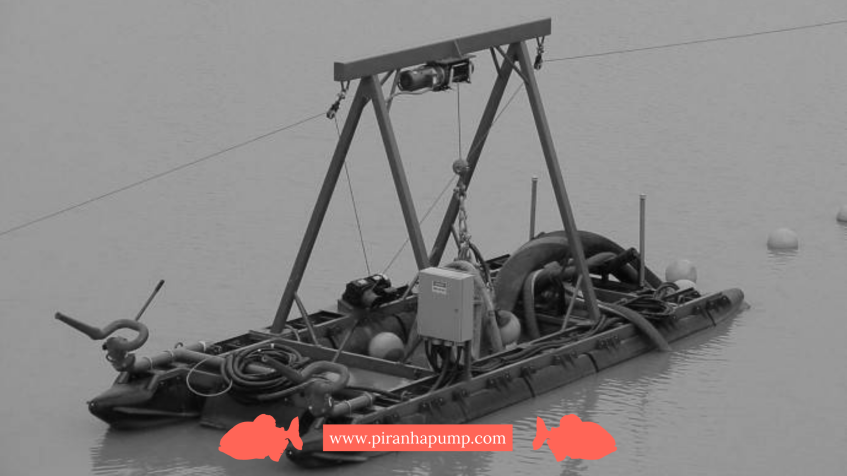When we think of dredging, we might conjure images of large machines scooping up mud from the bottom of a river or lake. While this image is close, dredging is a multifaceted process with applications ranging from construction projects to environmental preservation. Whether you just want to know the broad strokes of dredging or want to know the specifics of how it can help your business specifically, we'll explore dredging's mechanisms, advantages, and applications, all with the expertise of Piranha Pumps.
How Does Dredging Work?
What are the basics of dredging? Dredging is the process of excavating and removing sediment and debris from the bottom of bodies of water, such as rivers, lakes, and harbors. This technique proves crucial for maintaining waterway depths, preventing flooding, and restoring aquatic habitats. On the developmental side of things, dredging clears work areas or can make them accessible after a flood or a storm.
What Are the Different Types of Dredges?
Dredges come in various forms, each designed for specific purposes and environments. Here are some common types:
- Suction Dredges: These dredges utilize a suction pump to remove sediment from underwater surfaces. A cutting suction dredger (CSD) has a slicing tool at its head, which loosens sediment so it can be suctioned more easily.
- Mechanical Dredges: Mechanized dredges employ cutting or scraping mechanisms to dislodge and remove sediment and are well-suited to working in confined areas. They also allow for a higher degree of precision.
- Hopper Dredges: These large-scale vessels carry a large hopper for storing dredged material, and are often used for deepening ports and harbors.
- Hydraulic Dredges: Hydraulic dredges create slurries to pump sediment away.
- Mini Dredges: Piranha Pumps is proud to have developed the mini dredge. This affordable and highly user-friendly option is the perfect unit for mid-sized and small-scale dredging projects.
What Is Dredging Used For?
Industrial Functions
Dredging plays a vital role in numerous industrial applications, including:
- Construction: Dredges are employed to excavate and remove sediment from water bodies, clearing the way for infrastructure development such as bridges, ports, and buildings.
- Maintaining Shipping Channels: Dredging ensures that ports and harbors remain navigable for ships, facilitating trade and commerce. This is vital for supply chains to stay functional.
- Extracting Resources: Suction dredge mining equipment is employed in mining operations to extract valuable minerals and ores from underwater deposits.
Environmental Functions
Beyond its industrial applications, dredging serves essential environmental functions:
- Maintaining Existing Waterways: Regular dredging prevents sediment buildup, maintains flow, and reduces the risk of flooding.
- Ecological Benefits: Dredging can improve water quality by removing pollutants and excess nutrients, leading to healthier aquatic ecosystems.
What Are the Advantages of Dredging?
Commercial Benefits
- Improved Navigation: Dredging shipping channels and harbors allows vessels to navigate safely and efficiently, supporting global trade.
- Increased Land Availability: Dredging can create land for development and construction projects, expanding waterfront areas for residential or commercial use.
Environmental Benefits
- Habitat Restoration: Dredging projects can restore degraded habitats, enhancing biodiversity and supporting threatened species.
- Flood Prevention: By maintaining proper water depths, dredging reduces the risk of flooding in coastal and riverine areas, protecting communities and infrastructure.
Did you know? Piranha Pumps offers Delivery & Startup. We deliver to your job site and furnish a service technician for startup.
Different Types of Dredges
We at Piranha Pumps know how important it is to select the right tool for the job. Our industrial dredging systems come furnished with a large floating platform, among other things. Here are a few examples of specialized applications:
- Pond Dredges: Ideal for cleaning and maintaining ponds, these dredges efficiently remove sediment and debris.
- Lake Dredges: Designed for larger bodies of water, lake dredges effectively clear sediment to improve water quality and depth.
- Canal Dredges: These dredges are engineered explicitly for clearing canals and waterways, ensuring smooth navigation and water flow.
How Is The Dredging Waste Disposed Of?
As you can see, dredging clears the way for projects, people, and the environment. But what happens on the other side? Dredged material can be disposed of in several ways, depending on its composition and environmental regulations. Standard disposal methods include:
- Ocean Disposal: Sometimes, dredged material is safely deposited in designated offshore disposal sites.
- Land Disposal: Dredged material may be used for land reclamation or deposited in containment areas on land.
- Beneficial Reuse: Cleaned and treated sediment can be repurposed for activities such as beach nourishment or soil improvement projects.
In conclusion, dredging is a versatile process with far-reaching applications in industry and environmental conservation. Whether deepening shipping channels or restoring aquatic habitats, the expertise and equipment provided by Piranha Pumps ensure efficient and environmentally responsible dredging solutions. Dive into the world of dredging with Piranha Pumps and unlock efficiency and profitability for your business by investing in quality water dredging equipment. Contact us today to get your project underway!
 PIRANHA
PIRANHA
